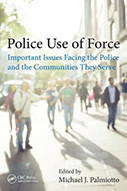POLICE USE OF FORCE: IMPORTANT ISSUES FACING THE POLICE AND THE COMMUNITIES THEY SERVE

Editor: Michael J. Palmiotto
Publisher: New York, NY: CRC Press, 2017. 196p.
Reviewer: Sheryl L. Van Horne | October 2017
Police Use of Force, edited by Michael Palmiotto, includes a wide breadth of information pertaining to police use of force. Through eleven chapters and nine experts in their fields (criminal justice, psychology, law, technology, and political science), this book investigates the historical, legal, sociological, and psychological factors related to the use of force, the excessive use of force, and the use of deadly force. It also provides methods of limiting excessive use of force by police.
As an edited volume there is some repetition of concepts and cases, but the overlap is not necessarily redundancy and, in fact, contributes to the argument at hand.
Dr. Michael Palmiotto, former New York police officer, has published numerous books, book chapters, and articles on policing-related topics.
Through specific examples, the book begins with a historical overview of the use of force within law enforcement agencies from ancient Egypt, to ancient Greece, from France to England, emphasizing English political and social history.
Chapter 2 examines the concept of force and then introduces the concept of excessive use of force. This chapter covers the legal basis of the use of force, possible explanations for it, and the various types of excessive force. The third chapter focuses on legal and historical applications of the use of force, highlighting Tennessee v. Garner.
Chapter 4 critically examines police use of non-lethal weapons and body cameras, while chapter 5 chronicles the history of the militarization of the police and how military hierarchy has extended into policing in some locales.
Racial profiling is covered extensively in chapter 6, incorporating a socio-historical examination of racial profiling since slavery, through high profile narratives. This chapter also focuses on a study in which 87 minorities who reported that they had been racially profiled by the police were interviewed. The participants discussed the emotional toll the experience had on them with several other themes arising: vehicle and geographic stereotyping, pre-textual stops, being treated like criminals, and the normalization of the experience for some. Chapter 6 then examines potential solutions to racial profiling, focusing on training.
Chapter 7 focuses on the legal responses to the use of force, which include prosecuting excessive force allegations, criminally and civilly. This chapter includes a discussion on the typical defenses raised in such cases.
Chapters 8 and 9 find explanations for using excessive force. Chapter 8 provides psychological and social correlates, providing an in-depth analysis of a variety of contributory factors, from personality to community characteristics. A variety of sociological theories are a little too briefly applied. Chapter 9 focuses on public response to police violence, noting that different subgroups of the population view police actions differently. For example, compared to whites, African Americans are more likely to view police treatment of minorities in a less positive light. Social capital and actions by groups (such as voting) are relevant to the discussion of the use of force.
The final substantive chapter seeks a solution to the excessive use of force through prevention efforts and training, providing a critical examination of how recruitment, hiring, and evaluating officers could reduce excessive force complaints.
This edited book provides a comprehensive understanding of the use of force from multiple perspectives. It is very informative and current, both in the subject matter and the references. This book would work well for a special topics course for an undergraduate or graduate class and should be read by practitioners and policy-makers.
Sheryl Van Horne is the Program Director of Criminal Justice at Eastern University in St. Davids, PA.


